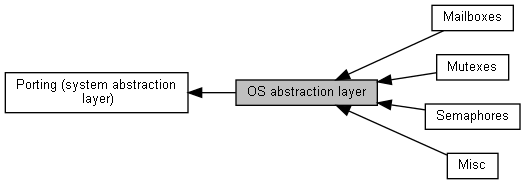
Modules | |
| Semaphores | |
| Mutexes | |
| Mailboxes | |
| Misc | |
Detailed Description
No need to implement functions in this section in NO_SYS mode. The OS-specific code should be implemented in arch/sys_arch.h and sys_arch.c of your port.
The operating system emulation layer provides a common interface between the lwIP code and the underlying operating system kernel. The general idea is that porting lwIP to new architectures requires only small changes to a few header files and a new sys_arch implementation. It is also possible to do a sys_arch implementation that does not rely on any underlying operating system.
The sys_arch provides semaphores, mailboxes and mutexes to lwIP. For the full lwIP functionality, multiple threads support can be implemented in the sys_arch, but this is not required for the basic lwIP functionality. Timer scheduling is implemented in lwIP, but can be implemented by the sys_arch port (LWIP_TIMERS_CUSTOM==1).
In addition to the source file providing the functionality of sys_arch, the OS emulation layer must provide several header files defining macros used throughout lwip. The files required and the macros they must define are listed below the sys_arch description.
Since lwIP 1.4.0, semaphore, mutexes and mailbox functions are prototyped in a way that allows both using pointers or actual OS structures to be used. This way, memory required for such types can be either allocated in place (globally or on the stack) or on the heap (allocated internally in the "*_new()" functions).
Note:
Be careful with using mem_malloc() in sys_arch. When malloc() refers to mem_malloc() you can run into a circular function call problem. In mem.c mem_init() tries to allocate a semaphore using mem_malloc, which of course can't be performed when sys_arch uses mem_malloc.